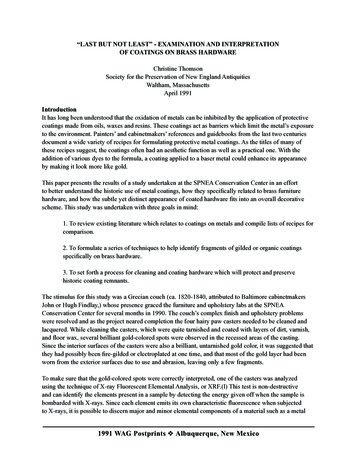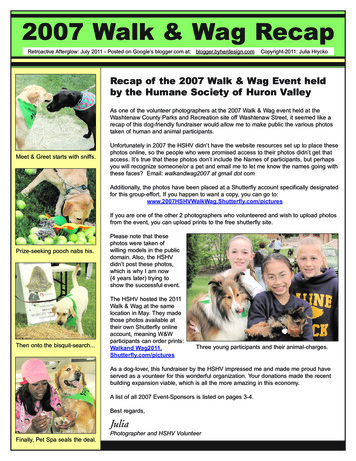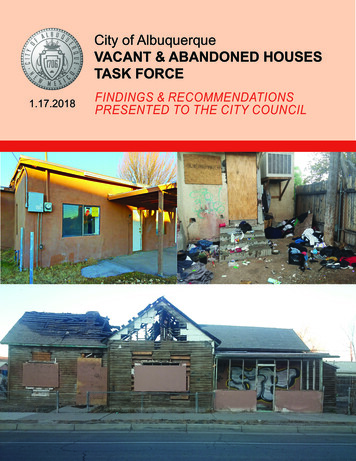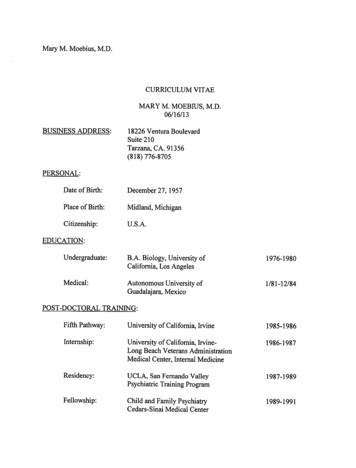
Transcription
“LAST BUT NOT LEAST” - EXAMINATION AND INTERPRETATIONOF COATINGS ON BRASS HARDWAREChristine ThomsonSociety for the Preservation of New England AntiquitiesWaltham, MassachusettsApril 1991IntroductionIt has long been understood that the oxidation of metals can be inhibited by the application of protectivecoatings made from oils, waxes and resins. These coatings act as barriers which limit the metal’s exposureto the environment. Painters’ and cabinetmakers’ references and guidebooks from the last two centuriesdocument a wide variety of recipes for formulating protective metal coatings. As the titles of many ofthese recipes suggest, the coatings often had an aesthetic function as well as a practical one. With theaddition of various dyes to the formula, a coating applied to a baser metal could enhance its appearanceby making it look more like gold.This paper presents the results of a study undertaken at the SPNEA Conservation Center in an effortto better understand the historic use of metal coatings, how they specifically related to brass furniturehardware, and how the subtle yet distinct appearance of coated hardware fits into an overall decorativescheme. This study was undertaken with three goals in mind:1. To review existing literature which relates to coatings on metals and compile lists of recipes forcomparison.2. To formulate a series of techniques to help identify fragments of gilded or organic coatingsspecifically on brass hardware.3. To set forth a process for cleaning and coating hardware which will protect and preservehistoric coating remnants.The stimulus for this study was a Grecian couch (ca. 1820-1840, attributed to Baltimore cabinetmakersJohn or Hugh Findlay,) whose presence graced the furniture and upholstery labs at the SPNEAConservation Center for several months in 1990. The couch’s complex finish and upholstery problemswere resolved and as the project neared completion the four hairy paw casters needed to be cleaned andlacquered. While cleaning the casters, which were quite tarnished and coated with layers of dirt, varnish,and floor wax, several brilliant gold-colored spots were observed in the recessed areas of the casting.Since the interior surfaces of the casters were also a brilliant, untarnished gold color, it was suggested thatthey had possibly been fire-gilded or electroplated at one time, and that most of the gold layer had beenworn from the exterior surfaces due to use and abrasion, leaving only a few fragments.To make sure that the gold-colored spots were correctly interpreted, one of the casters was analyzedusing the technique of X-ray Fluorescent Elemental Analysis, or XRF.(l) This test is non-destructiveand can identify the elements present in a sample by detecting the energy given off when the sample isbombarded with X-rays. Since each element emits its own characteristic fluorescence when subjectedto X-rays, it is possible to discern major and minor elemental components of a material such as a metal1991 WAG Postprints Albuquerque, New Mexico
or paint pigment. Surprisingly, analysis of the caster using this technique yielded no evidence that goldwas present in the areas tested. Since these bright spots on the exterior surfaces also tended to fluoresceslightly under ultraviolet light, we determined that they were more likely remnants of an organic coating,rather than gold. The brilliant interiors of the casters still remained a mystery, as it was not possible forthe instrument to obtain a reading from such a confined space. Since then many pieces of brass hardwarehave been examined with the thought that all that glitters is not necessarily gold.A survey of historic literature relating to coatings on metalThere are many 18th and early 19th century references and guidebooks available to us which provideinformation and instructions on how to mix paints and varnishes with the materials available at thetime. Of the dozen or so surveyed for this project, virtually everyone which provides recipes for varnishincludes one or more recipes for a coating for metal. (See Appendix I for a bibliography of historic textssurveyed and compilation of recipes.) They are referred to by various names, such as “changing varnish”,“yellow varnish”, “gold lacquer” and “lacker”– the term used in the earlier guidebooks published inEngland. In general, the term “lacquer” or “lacker” refers to a coating for metal, whereas “varnish” hasbroader connotations.The recipes surveyed generally include in their ingredients alcohol (spirits of wine), a resin such as seedlac, colored resins such as dragon’s blood and gamboge, and various dyestuffs including saffron, tumericand annatto seeds. Two recipes were found which contained a drying oil in addition to other resins.The numerous coatings for metal had an array of purposes. Some were strictly functional, that is, provideda barrier between the polished metal and the atmosphere, thereby preventing tarnishing. Some coatingsincluded dyes, and could be applied to silver leaf to give it a golden glow or enhance the appearance of ametal of lesser value such as brass, by making it look more like its richer relative, gold. Many recipes hadvery revealing titles, such as the one from The Builder’s Dictionary which describes “A Varnish for BrassTo Make It Look Like Gold.” There are specific recipes for coating watch-cases and keys, and for coating“philosophical instruments.” Henry Carey Baird in The Painter, Gilder, and Varnisher’s Companion(Philadelphia, 1854) notes that “it would be an endless task to enumerate all the various kinds of changingvarnishes that can be made ” As a note of interest, Baird may have copied the chapters in his book onchanging varnishes and lacquering verbatim from another book, published earlier in London and titledThe Painter’s and Varnisher’s Pocket Manual, and he certainly wasn’t the only one guilty of rampantplagiarism because The Painter’s and Varnisher’s Pocket Manual in turn may have copied the informationcontained in the well-known The Painter and Varnisher’s Guide by P.F. Tingry, published in 1816. Manyother authors apparently had no qualms about lifting material from other sources and as there were nolaws preventing such actions, the same recipes keep occurring over and over in different sources. Aslate as 1921, the same recipes were being published for the same purposes, and utilizing the same basicingredients. (2)In addition to coatings prescribed for baser metals, there are recipes for coatings especially for applicationto gilded surfaces. There is a reference to a “Gold Lacker Varnish” in a pamphlet titled “Genuine Receiptfor making the Famous Vernis Martin, etc.,” (published in Paris and Dublin, 1776); the purpose of whichwas to enhance the gold and give it a “pleasing but magnificent appearance”, not unlike a vermeil.We know that much of the brass hardware that came to America from England in the 18th and 19thcenturies was manufactured at factories in the Midlands district, concentrated in and around the city of1991 WAG Postprints Albuquerque, New Mexico
Birmingham. A few hardware catalogs survive from a company called W. Walker & Sons in Birmingham,and can be found in the SPNEA archives. They include a numbered drawing for each piece of hardwareavailable, along with an occasional description of the finish, i.e. hinged hooks are “burnish’d and lackerd”and “strong stop butts (hinges) either lacq.d or white”.A book titled The Resources. Products and Industrial History of Birmingham and the Midland HardwareDistrict, published in London in 1866 and edited by Samuel Timmins, describes the manufacture ofstamped brass hardware and notes that it is always lacquered as the last step in its manufacture. It goeson to describe in great detail the recipes and techniques used for coating the hardware. In this book, andin nearly all the guidebooks surveyed, it is suggested that the metal be heated either before or after theapplication of the coating to render the coating more transparent and durable. with the application of heat,crosslinking of the resin occurs, making the coating harder and insoluble in most solvents.Other routine treatments to brass hardware described in Timmins’ book were the process of dipping, and“dead dipping”. Dipping refers to the process of submerging the hardware in mild acid, which removesany fire scale and tarnish, and prepares the metal for polishing and lacquering. It is common to seeunpolished, acid-dipped surfaces on the backs of stamped brasses. Dead dipping was a slightly morecomplicated process which involved dipping the hardware into acids of different strengths, and had theeffect of giving the brass surface a dull, lemony yellow color. This effect was desirable, especially whenparts of the same piece were burnished, giving a contrasting mat and burnished look to the metal, similarto that of French gilt bronze mounts applied to furniture. The contrasting of mat and burnished surfaces asa technique to enhance decoration in relief is seen also on gilded frames.We know that furniture brasses served a dual purpose – they were functional as well as decorative. Brasswas an obvious choice over other metals for decorative furniture hardware because it was relativelyinexpensive, had good working properties, tarnished more slowly as compared to other metals such asiron and silver, and looked a lot like gold when polished. Just as furniture required periodic refinishing,brasses would also eventually require repolishing. Their factory coatings would eventually degrade overtime and with use, allowing air to tarnish the brass underneath. Regimens of brass polishing existed inmany households, and involved andirons and door plates, and furniture brasses as well.(3) It is possiblethat coatings on brass may have been occasionally misunderstood and zealously polished with one of themany abrasive cleaners concocted for polishing other metals, resulting in abrasion and premature removalof the coating.As noted in the article on “The Care of Period Hardware” by Gregory Landrey and Helen Stetina,the need to occasionally recoat brasses was anticipated, and they cite Thomas Chippendale’s shopledger records in 1765 which bill for “Repair’g & cleaning a Mahogany desk.& new lackering thebrasswork.”(4) Since there are indications of hardware being coated at the time of manufacture andalso recoated when it was necessary to do so, it is therefore difficult to differentiate between an originalcoating and a later application. It is important to remember that when examining hardware, that there maybe no way to discern between an “original” and an “early” coating.One will occasionally come across brass hardware that has been fire-gilded. The technique of fire-gildingenabled a baser metal such as brass to be coated with a layer of real gold. An amalgam of gold andmercury was painted on the surface of the brass and the object was heated to the point where the mercuryvaporized, leaving the gold behind. (5) Fire-gilded hardware, called “ormoulu” by the French, is often1991 WAG Postprints Albuquerque, New Mexico
seen on American Empire-style furniture and furniture influenced by the French taste. Much fire-gildedhardware was imported from France, although occasionally we find gilded high-style hardware fromEngland.It is important to recognize fire-gilding as such and not confuse it with other types of coatings. Duringvisual examination one might notice a clue that indicates a fire-gilded surface – drips of gold along theedges which sometimes spillover to the ungilded back side of the hardware. Gold was expensive andthere was no point to putting gold on a surface that wouldn’t be seen. If, on the other hand, one observeswhat one thinks is gold on the back of a piece of hardware, it is possible that the hardware has beenelectroplated. The electroplating process requires that the hardware be dipped into a solution containingthe gold ions, so that plating occurs on both the front and back sides of the metal in contrast to firegilding, in which only the front sides of hardware were coated. Electroplated coatings also tended tobe much thinner – sometimes only molecules thick – and can easily be worn off during unwarrantedpolishing. To help determine if you have a layer of gold on a metal surface, you can use a spot test forgold. A simple spot testing method is described later.General Observations and Methods of ExaminationOnce the hardware has been removed from a piece of furniture for cleaning, it can be more easilyexamined for remnants of any early coatings. In some situations, however, it is not possible or appropriateto remove the hardware and examination must be conducted in situ. For instance, hardware attached withcotter pins should not be removed because the pins will break if bent; also on rare occasions one will seehardware with no signs of prior removal. In these situations, it is best to leave the hardware attached andexamine and clean in place.The following list of tools and methods for examination and interpretation of hardware coatings suggestsa low-tech approach to gathering information. Since the information gained from this type of examinationwill be of a general nature, it may be necessary to consider more sophisticated techniques of analysis ifmore specific data is required.1. If the hardware is particularly grimy, it is best to first remove surface dirt and accumulations of waxusing mineral spirits and a brush. Often on the backs of backing plates and escutcheons one canobserve the chalky white residue of brass polishes, active corrosion (a bright green powdery surface)and accumulated dirt. Brass polish residue and active corrosion are usually found together becausethe ammonia contained in most commercial brass polishes induces corrosion. These accretions areusually well-adhered to the surface of the metal and may be difficult to remove.2. Once the hardware is cleaned of major accretions, it can be examined under a microscope. The mostobvious places to find the remains of coatings are in recesses and crevices protected from light andhandling, such as areas on backing plates directly underneath bails. A coating will be more readilyapparent under the microscope as it has a reflective quality different from that of the bare metal.3. Examination under ultraviolet light can also be illuminating because any resinous organic coatingwill fluoresce whereas uncoated metal will not. Often remnants of coatings which fluoresce under UVlight will be concentrated around the edges of the piece of hardware. These coatings must be regardedwith some suspicion, however, because occasionally in its lifetime a piece of furniture gets a quickcoating of shellac or varnish by someone who doesn’t bother to take the brasses off, and some of the1991 WAG Postprints Albuquerque, New Mexico
varnish will invariably get on the hardware. Also, it is important to remember that synthetic coatingswill fluoresce very little or not at all.4. A simple battery continuity tester from the hardware store will also indicate the presence of a coatingby noting the disruption of an electrical current passed through the metal. It is also important tobe aware that corrosion products are also non-conductive, as they do not form a regular crystallinematrix in the same way that metal does.(6) The continuity tester is therefore unable to distinguishbetween an organic coating and a heavy tarnish layer and may give misleading information.5. Since one may occasionally encounter fire-gilding or gold electroplating, a spot test for gold isavailable which will not damage the surface of the metal or leave a large area of discoloration.It requires setting up an electrolysis apparatus (See figure 1), and touching a piece of filter papermoistened with a saturated solution of NaCl to the suspected gold layer. If the gold is not pure, andcontains copper or some other metal, a slight discoloration of the metal will result at the point ofcontact with the filter paper. The filter paper is then dipped into a mixture of 20% SnC12/15% HCl,and if gold is present, the filter paper will immediately turn black. Presence of copper or silver ionswill not adversely affect the test. The obvious advantage of this type of test compared to other spottests is that it is only the filter paper which comes into contact with the metal surface, and not a dropof reagent, which can easily spread uncontrolled and damage a larger area.Another frequent phenomenon is a bright, untarnished surface on the back of a stamped plate or insidea caster. Mistaken by some people for gold, it is more likely an acid-dipped surface which has been in amicroclimate created by the attachment of the hardware to either bare wood or a finished wood surface.Because there is less interaction with the atmosphere, the process of oxidation involving these interiorsurfaces proceeds at a slower rate.Contextual information is also important to consider. The location of the piece of hardware, its originality,whether it has ever been removed, and whether the finished wood surface surrounding it has beenrefinished are all significant sources of information about the hardware’s history. Brass latches with aremarkably intact early coating were discovered in the interior of a cabinet in the SPNEA collection,where they were protected from light and regular use.Treatment of hardware retaining fragments of historic coatingsThe routine treatment for hardware at the SPNEA Conservation Center is based on the procedure followedat the Henry Francis duPont winterthur Museum. (8) After examination, the hardware is cleaned of dirtand other unwanted coatings with solvents, dipped in a solution of thiourea and acid to reverse corrosionproducts, polished with mild abrasives, and coated with a nitrocellulose lacquer made expressly formetals. (see Appendix II - Cleaning Procedure for Brass Hardware)It is not unusual to see hardware without a trace of any kind of coating. Chippendale-style backing platesand escutcheons have no recessed decoration and their flat, unbroken surfaces invited frequent polishing,so one rarely encounters historic coatings on this style of drawer hardware. Also, reproductions of periodhardware have been made over the years, and one prominent manufacturer, Ball and Ball of Exton, PAsells brass hardware with either a polished or “antiqued” surface, neither of which is coated.If we do find remnants of a coating that we feel are significant, the cleaning procedure can be adjusted to1991 WAG Postprints Albuquerque, New Mexico
accommodate them. Since many of the historic coatings are resin-based, they will be sensitive to alcohols,so it is best to substitute other solvents for cleaning. The thiourea dip can still be used when coatings arepresent, and in some situations rather than dipping the entire piece of hardware into the solution, we willroll a swab soaked in the solution over the tarnished areas. When polishing, we can restrict the abrasiveto the tarnished areas of the metal while avoiding the coatings that we feel are significant and worthpreserving. Partial polishing may result in uneven coloring, which may not be as noticeable from a slightdistance. Allowing the polished brasses to sit exposed to the air for a few weeks before coating will causethe newly-polished surfaces to “mellow” and better blend with the coated surfaces.Lastly, when it comes to choosing a synthetic coating to seal the newly-cleaned and polished brasses, wemight opt for an acrylic resin instead of nitrocellulose lacquer, which contains solvents that could partiallydissolve historic resin coatings. Acryloid B-72 forms a coating which is softer than nitrocellulose lacquer,and can be dissolved in toluene, which has only a minimal effect on a resin coating. (9) B-67 in mineralspirits would be an ideal film from the point of view of reactivity with any resinous coating remnants, butit forms an even softer coating which may not be appropriate in a situation where the hardware is handledregularly. An advantage of B-72 is that it can be tinted with chemical dyes such as Ciba-Geigy OrasolSolvent-Soluble Dyes (Ciba-Geigy Corp., Hawthorne, NY) to more resemble the color of a shellac orcolored resin coating. The tinted B-72 can then be applied with an airbrush, and sandwiched in betweentwo clear airbrushed coats of B-72.Figure 1Unfortunately, the natural dyes and colored resins included in historic recipes tended to be very fugitive,and the coating remnants we see today may not bear any resemblance to their original appearance.Through experimentation with early recipes and speculation, may we be able to recreate the dazzlingfinishes of the originals.1991 WAG Postprints Albuquerque, New Mexico
Suggestions for further studyThis study has barely scratched the surface of this large and interesting subject, but has hopefullyprovided inspiration to others to pursue related topics. Case studies of specific examples of differentcoatings should be held up to more sophisticated techniques of analysis, as it might be useful to discernspecific components of the coatings in question. Another related topic which was not elaborated uponis that of pickling and chemical patination techniques which were occasionally employed to give a basemetal a more interesting color. There is a thorough discussion of this topic in a source titled ScientificAmerican Handy Book of Facts and Formulae (Munn & Co, Inc., New York, 1921). In addition, furtherstudy and comparison of the colors created by the multitude of recipes for metal coatings would yieldinformation which would allow us to better understand and more accurately represent the craftsman’soriginal intent.AcknowledgementsI would like to thank the following people who took time to answer my incessant questions and inquiries:Deborah Bigelow, Mel Wachowiak, Scott Merritt, Henry Lie, and Don Fennimore. I am also indebtedto David Mitchell for editing help, David Bayne for co-writing the original “Procedure For TreatingBrass Hardware” and to my colleagues at SPNEA Joe Godla, Joe Twichell, Susan Buck, Kevin Green,Conservation Center Director Pat Weslowski for their notes, advice and support.Notes1. X-Ray Fluorescent Elemental Analysis of the caster was conducted at the Fogg Art Museum,Cambridge, MA in March, 1990.2. This very interesting book, Scientific American Handy Book of Facts and Formulae (Munn & Co., Inc.,New York, 1921), includes over 40 recipes for lacquers for metal, some of which are arranged in chartform according to their ingredients and the color they produce. These are the same formulas that appear inthe earlier guidebooks. The technology changed very little over 100 years.3. At Home - The American Family 1750 - 1870 by Elizabeth Donaghy Garrett (Abrams & Co., NewYork, 1990) makes several references to the importance of polishing the brass objects, including thebrasses on furniture, as part of routine housekeeping.4. Article by Gregory Landrey and Helen Stetina, “The Care of Period Hardware,” gives a procedure forcleaning and coating brass hardware.5. The technique of fire-gilding is illustrated in A Diderot Pictorial Encyclopedia of Trades and Industry,(Dover Publications, Inc., New York, 1959) Volume 2, plate 421.6. Schrager, Arthur M. Elementary Metallurgy and Metallography (Dover Publications, Inc., New York, 1969).7. Laver, Marilyn “Spot Tests in Conservation: Metals and Alloys”, ICOM Committee for conservation,Zagreb, 1978.8. Heller, Don “The Coating of Metal Objects At Winterthur”, AIC presentation, 1983.9. Horie, C.V. Materials for Conservation, (Butterworth’s, London, 1987) gives solubility perameters forshellac, p. 217.1991 WAG Postprints Albuquerque, New Mexico
APPENDIX IThe following list of period guidebooks and references surveyed for this study includes representativeingredients for lacquers and metal coatings included in each text.The Builder’s Dictionary or, Architect’s Companion. London, 1734Describes “A Varnish for Brass to make it look like gold”, designed to be used on leaf gold orbrass.2 qts. spirit of wine1 oz. gamboge2 oz. lake2 oz. gum masticClarke, Hewson and John Dougall. The Cabinet of Arts. M’Gowan, London, 1823Many, many recipes for varnishes, including one for “Gold - colour varnish, or Lacker”.8 oz. amber2 oz. lacca8 oz. drying oiloil of turpentine, colored with annatto, saffron, and dragon’s bloodGenuine Receipt for Making the Famous Vernis Martin. Paris, 1776This small text (20 pages) includes a recipe for a varnish for gold, to give it a “pleasing butmagnificent appearance”.1 lb. gambouge4 oz. ornotto (annatto?)4 oz. Venice turpentine1 pt. turpentineadd some amber varnish, (sometimes an ounce of seedlac is also added)Hopkins, Albert, ed. Scientific American Handy Book of Facts and Formulae. New York: Munn & Co.,Inc., 1921Although this is a much later publication, it is significant in that the changing lacquer recipes andingredients it contains are virtually identical to the recipes of 100 years earlier. The lacquer forphilosophical instruments appears again as do several others. Most interestingly, it has a chart of19 different recipes, which are arranged according to their ingredients and the color they produce.The colors are described as fine pale, full yellow, gold, deep gold, red, and green for bronze,among others. This book is filled with interesting information on related subjects: there areextensive descriptions of patination processes, and techniques of acid dipping and gilding.Mackenzie, Colin. Mackenzie’s Five Thousand Receipts, etc. Philadelphia and Pittsburg: John J.Kay, 1830.“This varnish is meant to give a gold color to white metals.”8 oz. amber2 oz. gum lac1991 WAG Postprints Albuquerque, New Mexico
2 oz. drying linseed oil16 oz. essence of turpentinevarying quantities of the the following dyestuffs: annatto, terra merita, gumguttae and dragon’s bloodThe Painter, Gilder, and Varnisher’s Companion. 2nd ed., Philadelphia: Henry Carey Baird,1854The text on metal coatings is identical to that in The Painter’s and Varnisher’s Pocket Manual,published in 1826. Thfe recipes and text in this book were either taken from the earlier Painter’sand varnisher’s Pocket Manual, or they both may have borrowed from an even earlier publicationby P.F. Tingry, titled The Painter and Varnisher’s Guide (1816), which gives the same recipes andtechniques for making the lacquers and coating metals. There is a chapter titled “On Lacquering”which includes a lacquer for brass.6 oz. seed lac2 oz. amber or copal40 grains dragon’s blood30 grains extract of red sandal-wood36 grains oriental saffron4 oz. pounded glass (to help keep everything in solution)40 oz. very pure alcoholThe Painter’s and Varnisher’s Pocket Manual. London, 1826The text on metal coatings in this book also appears in The Painter and Varnisher’s Companion,published in Philadelphia in 1854, as well as in tingry’s The Painter and Varnisher’s Guide. Alongwith the recipe for “Lacquer for Brass” already cited under the other title, there is a “Lacquer forPhilosophical Instruments” and a “Gold-Coloured Lacquer for Brass Watchcases, Watchkeys, &c.Many recipes in this and many of the other guidebooks suggest that if you don’t like the color ofthe lacquer, you can always adjust the amount of dyestuff. For cleaning brass, they recommendfirst boiling the brass-work in lye, then putting into a pickle of aquafortis and water.for Philosophical Instruments:1 1/2 oz. gamboge4 oz. gum sandrac4 oz. gum elemi2 oz. best dragon’s blood1 1/2 oz. terra merita (Indian dye plant)4 grains oriental saffron2 oz. seed-lac6 oz. pounded glass40 oz. pure alcoholfor Brass Watchcases, Watchkeys, &c.:6 oz. seedlac2 oz. amber2 oz. gamboge24 grains extract of red sandal-wood in water60 grains dragon’s blood1991 WAG Postprints Albuquerque, New Mexico
36 grains oriental saffron4 oz. pounded glass36 oz pure alcoholRoubo, Andre Jacob. L’Art du Menuisier. Paris, 1774Section 4, paragraph 4: “Description and use of a varnish for gilding copper and other metals.” Itgoes by the name “English Varnish”.1/2 oz. yellow amber (or yellow Kauri)1/2 oz. crystallized lacquer gum (probably seed-lac)9 grains of saffron10 graind dragon’s blood10 oz. spirits of wineRoubo gives a detailed description of how to make and apply the varnish, and stresses theimportance of maintaining clean conditions. He also mentions that to clean a piece that isvarnished with this technique, one must never use any abrasive powder out only a clean soft clothdipped in tepid water.Stalker, John and George Parker. A Treatise of Japaning and Varnishing, etc. 1688. A Tiranti, London,1971.There are four different recipes for “lackers” but there is little description of what to do withthem. They do give a discussion of lackering burnished silver (leaf) to make it look like gold. Allfour recipes include spirit of wine, shell-lac or seed-lac, and various dyestuffs, such as turmerick,sangunis draconis, saffron and gambogium. Also a reference to a color called “Ornator”. Onerecipe includes venice turpentine so “you may lacker anything in the open Air.”Timmins, Samuel. The Resources, Products, and Industrial History of Birmingham and the MidlandHardware District. London, 1866This book devotes a whole chapter to the manufacture of brass objects, and discusses lacqueringat length along with other techniques for producing decorative finishes on brass hardware. Itgives a simple recipe for lacquer, and notes that the lacquer should “present that of pale Frenchbrandy ”seed lacspirits of wineturmeric, dragon’s blood, and sandal wood for imparting various shades of colourTingry, Pierre Francois. The Painter and Varnisher’s Guide. 2nd ed., London: 1816The earliest and most likely the original source for three recipes which appear in later texts.IX For Giving a Gold Tint to Articles of Brass6 oz. seedlac2 oz amber or copal40 grains dragon’s blood30 grains red sandal wood1991 WAG Postprints Albuquerque, New Mexico
36 grains hay saffron4 oz. pounded glass40 oz. spirits of
1991 WAG Postprints Albuquerque, New Mexico 1991 WAG Postprints Albuquerque, New Mexico "LAST BUT NOT LEAST" - EXAMINATION AND INTERPRETATION OF COATINGS ON BRASS HARDWARE Christine Thomson Society for the Preservation of New England Antiquities Waltham, Massachusetts April 1991 Introduction










